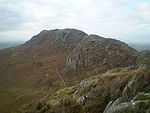St Cynhaearn's Church, Ynyscynhaearn
12th-century church buildings in Wales17th-century church buildings in WalesChurches preserved by the Friends of Friendless ChurchesChurchyards in WalesDolbenmaen ... and 4 more
Former churches in WalesGeorgian architecture in WalesGrade II* listed churches in GwyneddReligious buildings and structures completed in 1622

St Cynhaearn's Church is a redundant church standing in an isolated position on Ynyscynhaearna, a former island in Llyn (Lake) Ystumllyn, 900 metres (980 yd) south of the village of Pentrefelin, near Criccieth in Gwynedd, Wales. It is designated by Cadw as a Grade II* listed building. The church is approached from the village by an ancient causeway, and is in the care of the Friends of Friendless Churches.
Excerpt from the Wikipedia article St Cynhaearn's Church, Ynyscynhaearn (License: CC BY-SA 3.0, Authors, Images).St Cynhaearn's Church, Ynyscynhaearn
A497,
Geographical coordinates (GPS) Address External links Nearby Places Show on map
Geographical coordinates (GPS)
| Latitude | Longitude |
|---|---|
| N 52.9262 ° | E -4.1945 ° |
Address
Eglwys Sant Cynhaiarn
A497
LL52 0PT , Dolbenmaen
Wales, United Kingdom
Open on Google Maps










